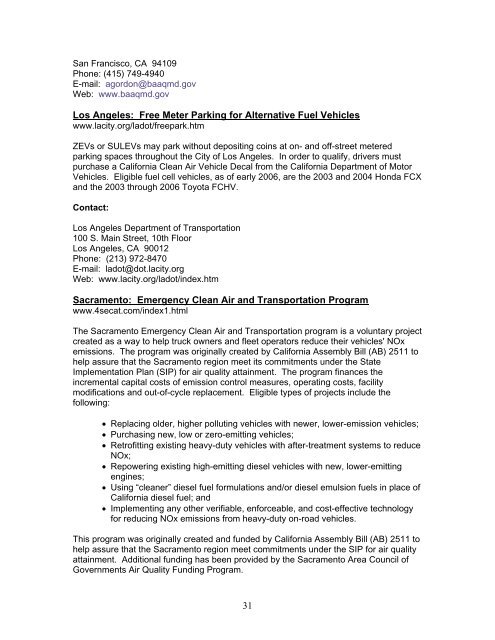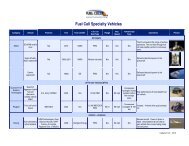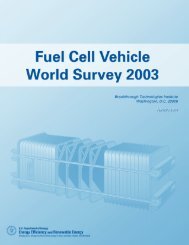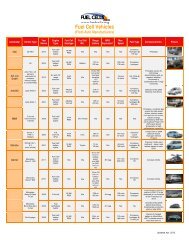Breakthrough Technologies Institute - Fuel Cells 2000
Breakthrough Technologies Institute - Fuel Cells 2000
Breakthrough Technologies Institute - Fuel Cells 2000
You also want an ePaper? Increase the reach of your titles
YUMPU automatically turns print PDFs into web optimized ePapers that Google loves.
San Francisco, CA 94109<br />
Phone: (415) 749-4940<br />
E-mail: agordon@baaqmd.gov<br />
Web: www.baaqmd.gov<br />
Los Angeles: Free Meter Parking for Alternative <strong>Fuel</strong> Vehicles<br />
www.lacity.org/ladot/freepark.htm<br />
ZEVs or SULEVs may park without depositing coins at on- and off-street metered<br />
parking spaces throughout the City of Los Angeles. In order to qualify, drivers must<br />
purchase a California Clean Air Vehicle Decal from the California Department of Motor<br />
Vehicles. Eligible fuel cell vehicles, as of early 2006, are the 2003 and 2004 Honda FCX<br />
and the 2003 through 2006 Toyota FCHV.<br />
Contact:<br />
Los Angeles Department of Transportation<br />
100 S. Main Street, 10th Floor<br />
Los Angeles, CA 90012<br />
Phone: (213) 972-8470<br />
E-mail: ladot@dot.lacity.org<br />
Web: www.lacity.org/ladot/index.htm<br />
Sacramento: Emergency Clean Air and Transportation Program<br />
www.4secat.com/index1.html<br />
The Sacramento Emergency Clean Air and Transportation program is a voluntary project<br />
created as a way to help truck owners and fleet operators reduce their vehicles' NOx<br />
emissions. The program was originally created by California Assembly Bill (AB) 2511 to<br />
help assure that the Sacramento region meet its commitments under the State<br />
Implementation Plan (SIP) for air quality attainment. The program finances the<br />
incremental capital costs of emission control measures, operating costs, facility<br />
modifications and out-of-cycle replacement. Eligible types of projects include the<br />
following:<br />
• Replacing older, higher polluting vehicles with newer, lower-emission vehicles;<br />
• Purchasing new, low or zero-emitting vehicles;<br />
• Retrofitting existing heavy-duty vehicles with after-treatment systems to reduce<br />
NOx;<br />
• Repowering existing high-emitting diesel vehicles with new, lower-emitting<br />
engines;<br />
• Using “cleaner” diesel fuel formulations and/or diesel emulsion fuels in place of<br />
California diesel fuel; and<br />
• Implementing any other verifiable, enforceable, and cost-effective technology<br />
for reducing NOx emissions from heavy-duty on-road vehicles.<br />
This program was originally created and funded by California Assembly Bill (AB) 2511 to<br />
help assure that the Sacramento region meet commitments under the SIP for air quality<br />
attainment. Additional funding has been provided by the Sacramento Area Council of<br />
Governments Air Quality Funding Program.<br />
31






